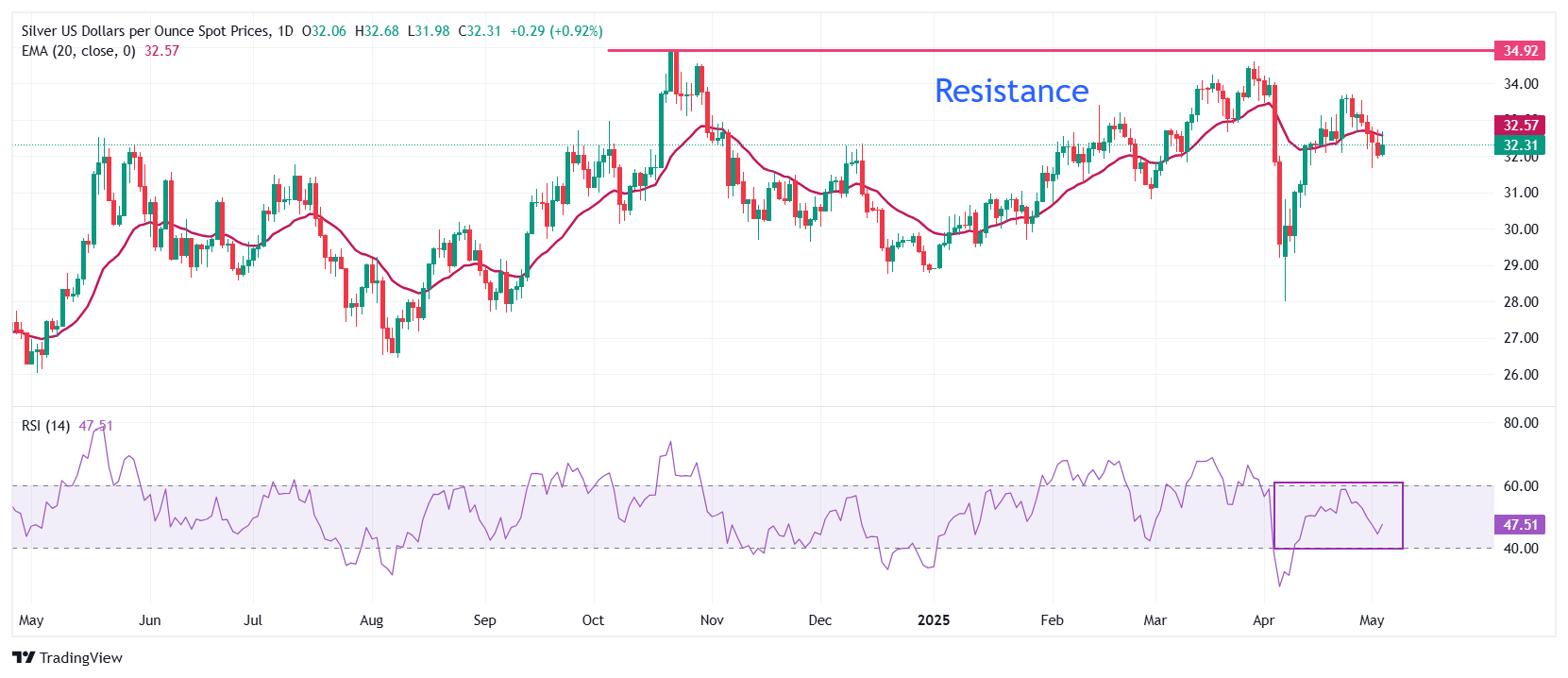Silver Price Forecast: XAG/USD surges to near $32.60 as US Dollar weakens, Fed policy in focus
- Silver price soars to near $32.60 amid weakness in the US Dollar.
- The Fed is almost certain to keep interest rates steady on Wednesday.
- US-China trade uncertainty keeps limiting the downside in the Silver price.
Silver price (XAG/USD) rallies to near $32.60 during North American trading hours on Monday. The white metal strengthens as the US Dollar (USD) slumps at the start of the week, with the Federal Reserve’s (Fed) monetary policy meeting in focus. Technically, a decline in the US Dollar makes investment in the Silver price an attractive bet for investors.
The US Dollar Index (DXY), which tracks the Greenback’s value against six major currencies, is down almost 0.5% around 99.50.
According to the CME Fedwatch tool, traders are almost certain that the central bank will leave interest rates steady on Wednesday. The tool also shows that the probability for the Fed to lower borrowing rates in June has dropped to 32% from 66% seen a week ago. Traders have pared Fed dovish bets for the June meeting after the release of the better-than-projected United States (US) Nonfarm Payrolls (NFP) data for April.
Theoretically, a high-interest-rate environment bodes poorly for non-yielding assets, such as Silver.
Meanwhile, diminishing hopes of a US-China trade war resolution in the near term have also supported the Silver price. The demand of safe-haven assets, such as Silver, increases amid heightening geopolitical tensions.
Trump said on Sunday that he is not going to speak with Chinese President Xi Jinping this week but expressed willingness to lower tariffs on China. At some point, I’m going to lower them, because otherwise, you could never do business with them, and they want to do business very much.”
On the economic front, US ISM Services PMI data for April has come in better than expected. The Services PMI expanded at a faster pace to 51.6 from 50.8 in March and estimates of 50.6.
Silver technical analysis
Silver price struggles to revisit an over three-week high around $33.70. The near-term outlook of the white metal has become uncertain as it falls below the 20-day Exponential Moving Average (EMA), which trades around $32.65.
The 14-day Relative Strength Index (RSI) falls below 50.00 after failing to break above 60.00, indicating that investors are not bullish anymore.
Looking up, the March 28 high of $34.60 will act as key resistance for the metal. On the downside, the April 11 low of $30.90 will be the key support zone.
Silver daily chart

Silver FAQs
Silver is a precious metal highly traded among investors. It has been historically used as a store of value and a medium of exchange. Although less popular than Gold, traders may turn to Silver to diversify their investment portfolio, for its intrinsic value or as a potential hedge during high-inflation periods. Investors can buy physical Silver, in coins or in bars, or trade it through vehicles such as Exchange Traded Funds, which track its price on international markets.
Silver prices can move due to a wide range of factors. Geopolitical instability or fears of a deep recession can make Silver price escalate due to its safe-haven status, although to a lesser extent than Gold's. As a yieldless asset, Silver tends to rise with lower interest rates. Its moves also depend on how the US Dollar (USD) behaves as the asset is priced in dollars (XAG/USD). A strong Dollar tends to keep the price of Silver at bay, whereas a weaker Dollar is likely to propel prices up. Other factors such as investment demand, mining supply – Silver is much more abundant than Gold – and recycling rates can also affect prices.
Silver is widely used in industry, particularly in sectors such as electronics or solar energy, as it has one of the highest electric conductivity of all metals – more than Copper and Gold. A surge in demand can increase prices, while a decline tends to lower them. Dynamics in the US, Chinese and Indian economies can also contribute to price swings: for the US and particularly China, their big industrial sectors use Silver in various processes; in India, consumers’ demand for the precious metal for jewellery also plays a key role in setting prices.
Silver prices tend to follow Gold's moves. When Gold prices rise, Silver typically follows suit, as their status as safe-haven assets is similar. The Gold/Silver ratio, which shows the number of ounces of Silver needed to equal the value of one ounce of Gold, may help to determine the relative valuation between both metals. Some investors may consider a high ratio as an indicator that Silver is undervalued, or Gold is overvalued. On the contrary, a low ratio might suggest that Gold is undervalued relative to Silver.
